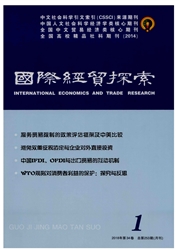

 中文摘要:
中文摘要:
在金砖国家国际投入产出模型的基础上,从全球价值链角度对一国出口的贸易价值进行分解,并对模型中所包含经济体的出口贸易价值含量进行测算与比较,结果显示:中国与印度出口中的国内价值含量较低,以低技术制造业为主,面临"价值链地位固化"的风险;巴西与俄罗斯出口中的国内价值含量较高,但主要集中在初级产业与资源密集型产业,贸易利益获取的可持续性较弱。金砖国家之间提供的贸易价值含量较少,内部出口贸易价值的互利性不强;金砖国家高端产业出口中的国内价值含量较低,来源于发达国家的价值含量较高。因此,金砖国家应努力改善自身在全球生产网络中的价值链地位,构建利益共享的价值链体系,相互推动产业升级,实现共同发展。
 英文摘要:
英文摘要:
Based on the international input-output model of BRICs, this paper decomposes the export trade value from the perspective of global value chain, and measures and compares the export trade value of economic entities in the model. It shows that the domestic value of Chinese and Indian exports is low and takes the low- technology manufacturing as the main industry, facing the risk of "the solidification of value chain position". Although the domestic value of Brazil and Russia's exports is high, it concentrates in the primary sectors and resource- intensive industries, so the sustainability of trade interests obtained is low. The trade value supplied among BRICs is low, and the mutual interest of the internal export trade is weak. In the BRICs, the export's domestic value of high-tech industry is relatively low, and the value sourced from the developed countries is high. Therefore, the BRICs should strive to improve their position in the value chain of global production network, build a shared value chain system, and promote industrial upgrading, so as to achieve their common development.
 同期刊论文项目
同期刊论文项目
 同项目期刊论文
同项目期刊论文
 期刊信息
期刊信息
